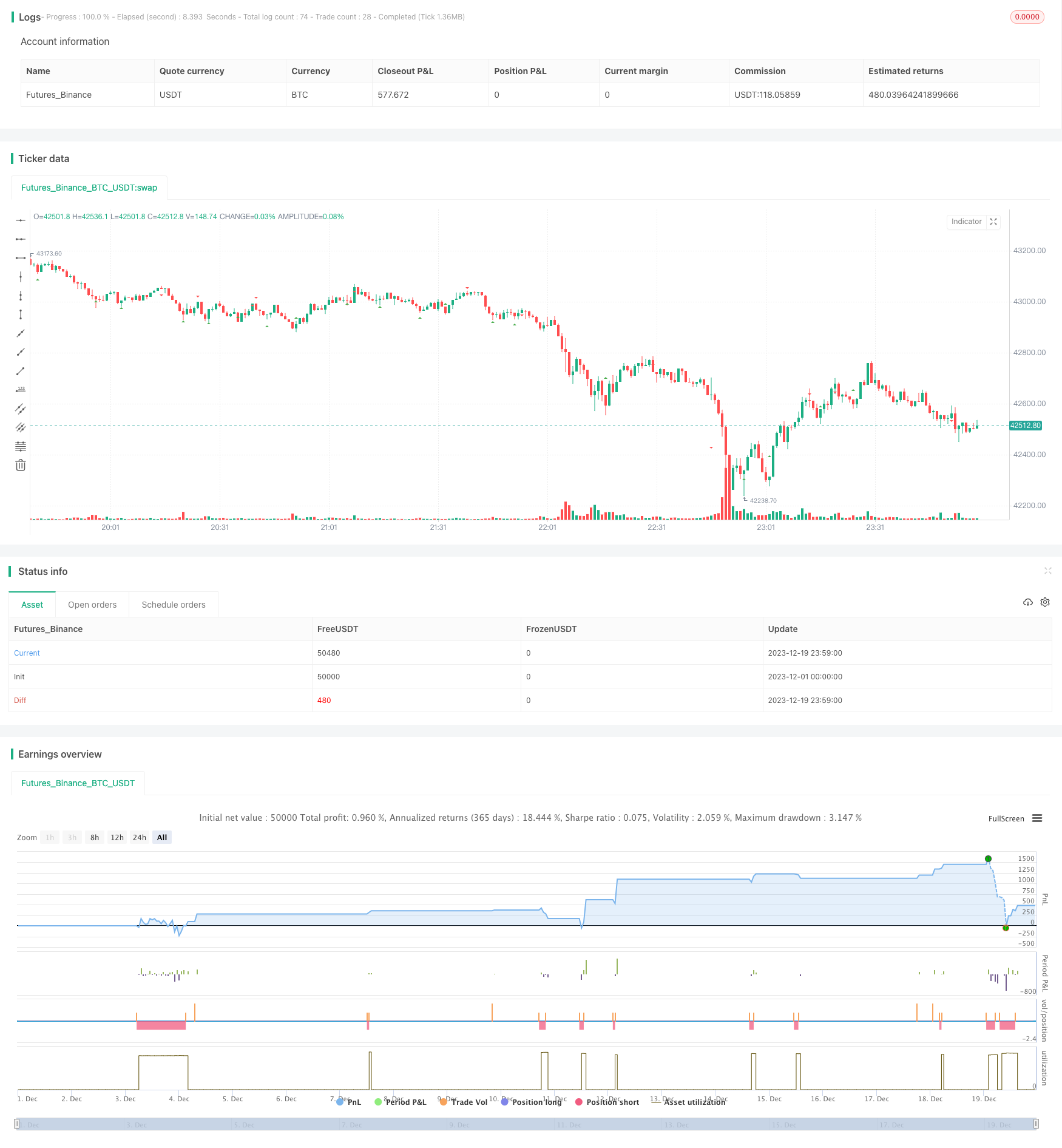Pivot Point and Fibonacci Retracement Based Automatic Trend Following Strategy
Author: ChaoZhang, Date: 2024-01-05 11:34:17Tags:

Overview
This strategy automatically identifies ABC patterns in stock prices based on pivot points and Fibonacci retracement ratios, and generates long/short signals. It uses pivot points to determine price waves and calculates Fibonacci retracement ratios between ABC waves. If the ratios meet certain criteria, trading signals are generated.
Strategy Logic
- Calculate the stock’s pivot high and low points
- Judge if the price has fallen from the previous high point or risen from the previous low point
- Calculate the Fibonacci retracement ratio between the current wave and previous wave
- If the retracement ratios of both up and down waves are within proper ranges, determine a potential ABC pattern
- After ABC pattern confirmation, set stop loss at Point C for long, and Point A for short. Set take profit at 1.5 times the price wave range.
Advantage Analysis
- Pivot points identify key support/resistance levels to improve signal accuracy
- Fibonacci retracements catch trend turning points by identifying ABC patterns
- Clear profit/loss rules avoid huge losses
Risk Analysis
- Pivot points and Fibonacci retracements cannot ensure perfect identification of every trend turning point. Misjudgements may occur.
- Point C and Point A stops can be broken through, leading to larger losses
- Parameters like Fibonacci retracement ratio ranges need further optimization
Optimization Directions
- Incorporate more technical indicators to assist ABC pattern confirmation, improving signal accuracy
- Optimize Fibonacci retracement ratio ranges to suit more market conditions
- Utilize machine learning methods to train ABC pattern recognition models
Conclusion
This strategy identifies ABC patterns for generating long/short signals at trend turning points, based on pivot point confirmation of key support/resistance levels, and Fibonacci retracement ratio calculations. The logic is simple and clean, with sensible profit/loss rules that effectively control risks. However, certain misjudgement risks remain, requiring further optimizations and improvements to suit more market conditions.
/*backtest
start: 2023-12-01 00:00:00
end: 2023-12-19 23:59:59
period: 1m
basePeriod: 1m
exchanges: [{"eid":"Futures_Binance","currency":"BTC_USDT"}]
*/
// This source code is subject to the terms of the Mozilla Public License 2.0 at https://mozilla.org/MPL/2.0/
// © kerok3g
//@version=5
strategy("ABCD Strategy", shorttitle="ABCDS", overlay=true, commission_value=0.04)
calcdev(fprice, lprice, fbars, lbars) =>
rise = lprice - fprice
run = lbars - fbars
avg = rise/run
((bar_index - lbars) * avg) + lprice
len = input(5)
ph = ta.pivothigh(len, len)
pl = ta.pivotlow(len, len)
var bool ishigh = false
ishigh := ishigh[1]
var float currph = 0.0
var int currphb = 0
currph := nz(currph)
currphb := nz(currphb)
var float oldph = 0.0
var int oldphb = 0
oldph := nz(oldph)
oldphb := nz(oldphb)
var float currpl = 0.0
var int currplb = 0
currpl := nz(currpl)
currplb := nz(currplb)
var float oldpl = 0.0
var int oldplb = 0
oldpl := nz(oldpl)
oldplb := nz(oldplb)
if (not na(ph))
ishigh := true
oldph := currph
oldphb := currphb
currph := ph
currphb := bar_index[len]
else
if (not na(pl))
ishigh := false
oldpl := currpl
oldplb := currplb
currpl := pl
currplb := bar_index[len]
endHighPoint = calcdev(oldph, currph, oldphb, currphb)
endLowPoint = calcdev(oldpl, currpl, oldplb, currplb)
plotshape(ph, style=shape.triangledown, color=color.red, location=location.abovebar, offset=-len)
plotshape(pl, style=shape.triangleup, color=color.green, location=location.belowbar, offset=-len)
// var line lnhigher = na
// var line lnlower = na
// lnhigher := line.new(oldphb, oldph, bar_index, endHighPoint)
// lnlower := line.new(oldplb, oldpl, bar_index, endLowPoint)
// line.delete(lnhigher[1])
// line.delete(lnlower[1])
formlong = oldphb < oldplb and oldpl < currphb and currphb < currplb
longratio1 = (currph - oldpl) / (oldph - oldpl)
longratio2 = (currph - currpl) / (currph - oldpl)
formshort = oldplb < oldphb and oldphb < currplb and currplb < currphb
shortratio1 = (oldph - currpl) / (oldph - oldpl)
shortratio2 = (currph - currpl) / (oldph - currpl)
// prevent multiple entry for one pattern
var int signalid = 0
signalid := nz(signalid[1])
longCond = formlong and
longratio1 < 0.7 and
longratio1 > 0.5 and
longratio2 > 1.1 and
longratio2 < 1.35 and
close < oldph and
close > currpl and
signalid != oldplb
if (longCond)
signalid := oldplb
longsl = currpl - ta.tr
longtp = ((close - longsl) * 1.5) + close
strategy.entry("Long", strategy.long)
strategy.exit("Exit Long", "Long", limit=math.min(longtp, oldph), stop=longsl)
shortCond = formshort and
shortratio1 < 0.7 and
shortratio1 > 0.5 and
shortratio2 > 1.1 and
shortratio2 < 1.35 and
close > oldpl and
close < currph and
signalid != oldphb
if (shortCond)
signalid := oldphb
shortsl = currph + ta.tr
shorttp = close - ((shortsl - close) * 1.5)
strategy.entry("Short", strategy.short)
strategy.exit("Exit Short", "Short", limit=math.max(shorttp, oldpl), stop=shortsl)
- Trend Following Moving Average Trading Strategy
- Trend Following Momentum Breakout Strategy
- Breakout and Intelligent Bollinger Bands Price Channel Strategy
- Simple Trend Following Strategy
- Long Breakthrough Strategy Based on K-Line Construction
- Momentum Oscillating Moving Average Trading Strategy Based on Buffered Bollinger Bands
- Adaptive Backtest Date Range Selection Strategy Based on Double MA
- Multi-Timeframe Moving Average Crossover Optimization Strategy
- Breakthrough Tracking Strategy
- Adaptive Trading Strategy Based on Momentum Indicators
- Trend Following Strategy Based on EMA and MACD across Timeframes
- Multi-indicator Collision Reversal Strategy
- Trend Reversal Strategy Based on EMA and SMA Crossover
- DMI DPO Guard Strategy
- Trend Tracking Short-term Trading Strategy
- RSI Trend Following Bull Strategy
- RSIndex and Moving Average Combination Strategy
- Multi-timeframe MA Trend Following Strategy
- Dual Indicators Bottom Buying Strategy
- Bearish Engulfing Reversal Strategy